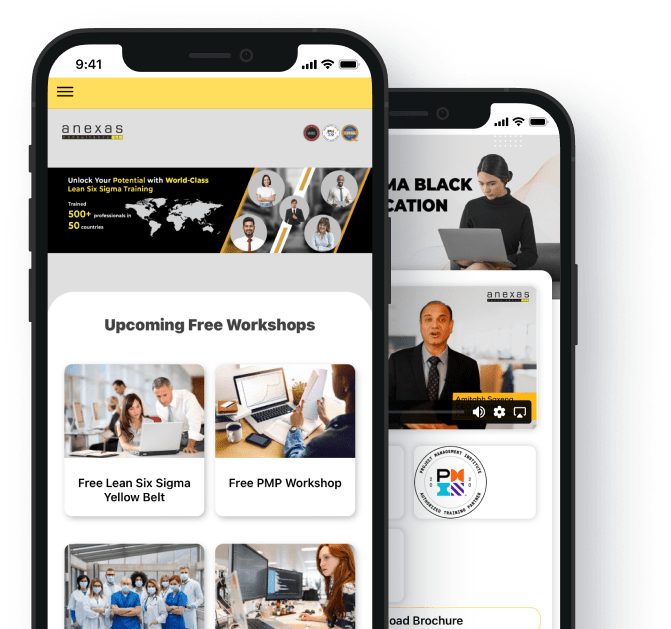The Crucial Role of Leadership in Driving Lean Six Sigma Success
Introduction to The Crucial Role of Leadership in Driving Lean Six Sigma Success
Explanation of Lean Six Sigma
Lean Six Sigma represents a powerful methodology for achieving operational excellence and driving continuous improvement within organizations. Rooted in the principles of efficiency, waste reduction, and quality management, Lean Six Sigma aims to streamline processes, eliminate defects, and enhance customer satisfaction. Lean focuses on minimizing waste and maximizing value, while Six Sigma emphasizes reducing variation and improving process stability. Together, they form a comprehensive approach to process improvement that has been widely adopted across industries ranging from manufacturing to healthcare to services.
Importance of Leadership in Lean Six Sigma
The success of Lean Six Sigma initiatives is heavily dependent on strong leadership commitment and involvement. Leaders play a pivotal role in setting the vision, providing resources, and fostering a culture conducive to continuous improvement. Without effective leadership, Lean Six Sigma efforts may falter, fail to gain traction, or remain confined to isolated pockets within an organization. Therefore, understanding the importance of leadership in Lean Six Sigma is essential for organizations seeking to harness its full potential.
Purpose of the article
This outline aims to explore the multifaceted role of leadership in Lean Six Sigma implementation, delving into strategies, challenges, best practices, and case studies to elucidate how leaders can create a culture of continuous improvement within their organizations. Through this exploration, the outline seeks to provide valuable insights for leaders, managers, and practitioners embarking on or overseeing Lean Six Sigma initiatives. By outlining the critical aspects of leadership in Lean Six Sigma, this paper aims to equip readers with the knowledge and tools necessary to drive successful implementation and sustainable improvement outcomes.

Understanding Lean Six Sigma
Definition and Origins
Lean Six Sigma is a comprehensive methodology aimed at improving business processes by eliminating waste, reducing variation, and enhancing efficiency and quality. Its origins can be traced back to the manufacturing sector, with Lean principles originating from the Toyota Production System (TPS) in Japan and Six Sigma emerging from Motorola in the United States. However, over time, Lean Six Sigma has evolved beyond its manufacturing roots and is now applied across various industries, including healthcare, finance, and hospitality.
Key Concepts and Methodologies
- Lean Principles: Lean principles focus on identifying and eliminating waste in processes to maximize value for customers. The key pillars of Lean include continuous improvement (Kaizen), respect for people, value stream mapping, flow, pull, and perfection. By streamlining processes and minimizing non-value-added activities, Lean aims to improve efficiency and responsiveness while reducing costs and lead times.
- Six Sigma Methodology: Six Sigma is a data-driven approach to process improvement that aims to reduce defects and variation to achieve near-perfect performance. It follows a structured problem-solving methodology known as DMAIC (Define, Measure, Analyze, Improve, Control), which provides a systematic framework for identifying root causes of problems, implementing solutions, and ensuring sustained improvement. Six Sigma relies heavily on statistical tools and techniques to measure process performance, identify sources of variation, and validate improvements.
- Integration of Lean and Six Sigma: The integration of Lean and Six Sigma combines the strengths of both methodologies to create a more comprehensive approach to process improvement. While Lean focuses on waste reduction and flow optimization, Six Sigma provides the analytical rigor and statistical methods necessary for identifying and eliminating defects. By integrating Lean and Six Sigma, organizations can achieve synergistic effects, resulting in faster cycle times, higher quality, and greater customer satisfaction.
Benefits of Lean Six Sigma Implementation
The implementation of Lean Six Sigma offers numerous benefits to organizations, including improved operational efficiency, enhanced product and service quality, reduced costs, increased customer satisfaction, and higher employee morale. By streamlining processes, reducing defects, and aligning activities with customer requirements, Lean Six Sigma enables organizations to achieve sustainable competitive advantage in today’s dynamic business environment. Furthermore, Lean Six Sigma fosters a culture of continuous improvement, empowering employees at all levels to identify opportunities for innovation and waste reduction. Overall, Lean Six Sigma serves as a powerful framework for driving organizational excellence and achieving business success.
Leadership’s Role in Lean Six Sigma
Definition of Leadership in this Context
In the context of Lean Six Sigma, leadership encompasses the ability to inspire, guide, and empower individuals and teams to achieve continuous improvement and organizational excellence. It involves setting a clear vision, providing direction, and creating an environment conducive to innovation, collaboration, and learning.
Importance of Leadership Commitment
Setting the Vision and Goals
Leadership commitment is crucial for establishing a compelling vision and goals for Lean Six Sigma initiatives. Leaders must articulate the strategic importance of continuous improvement and align Lean Six Sigma objectives with the organization’s overall mission and objectives.
Providing Resources and Support
Effective leaders ensure that the necessary resources, including budget, personnel, and technology, are allocated to support Lean Six Sigma initiatives. They create an infrastructure that enables teams to succeed by removing barriers and providing access to training, tools, and expertise.
Removing Obstacles
Leadership commitment involves actively addressing obstacles and challenges that may hinder the progress of Lean Six Sigma projects. Whether it’s bureaucratic red tape, organizational resistance, or lack of alignment with strategic priorities, leaders must intervene to facilitate progress and maintain momentum.

Leading by Example
Active Involvement in Improvement Projects
Leaders lead by example by actively participating in Lean Six Sigma improvement projects. By rolling up their sleeves and getting involved in problem-solving efforts, leaders demonstrate their commitment to driving change and fostering a culture of continuous improvement.
Demonstrating Commitment to Continuous Improvement
Leaders set the tone for continuous improvement by consistently seeking ways to enhance processes, systems, and outcomes. They embrace feedback, welcome new ideas, and champion innovative solutions that drive efficiency, quality, and customer satisfaction.
Fostering a Culture of Accountability
Leadership entails holding individuals and teams accountable for their performance and results. By establishing clear expectations, providing regular feedback, and recognizing achievements, leaders create a culture of accountability where employees feel empowered to take ownership of their work and contribute to organizational success.
Communicating the Vision
Ensuring Clarity of Purpose
Effective communication is essential for ensuring that everyone understands the purpose, objectives, and expected outcomes of Lean Six Sigma initiatives. Leaders must communicate the vision in a clear, compelling, and consistent manner to inspire commitment and alignment across the organization.
Aligning Objectives with Organizational Goals
Leadership communication involves aligning Lean Six Sigma objectives with broader organizational goals and priorities. By highlighting the strategic relevance of continuous improvement efforts, leaders help employees understand how their contributions contribute to the organization’s success.
Engaging Employees at All Levels
Leadership entails actively engaging employees at all levels of the organization in Lean Six Sigma initiatives. Leaders must create opportunities for dialogue, collaboration, and feedback to ensure that everyone feels valued, heard, and invested in the improvement process
Empowering Employees
Encouraging Innovation and Experimentation
Leadership involves empowering employees to challenge the status quo, experiment with new ideas, and take calculated risks to drive innovation and improvement. By fostering a culture of creativity and exploration, leaders unleash the full potential of their teams and unlock new opportunities for growth and success.
Providing Training and Development Opportunities
Leadership commitment to employee development includes providing training and development opportunities to enhance skills, knowledge, and capabilities related to Lean Six Sigma. By investing in continuous learning and professional growth, leaders empower employees to contribute meaningfully to Lean Six Sigma initiatives and advance their careers.
Recognizing and Rewarding Improvement Efforts
Leadership entails recognizing and rewarding individuals and teams for their contributions to Lean Six Sigma initiatives. Whether through formal recognition programs, incentives, or career advancement opportunities, leaders reinforce desired behaviors and outcomes, motivating employees to sustain their efforts and achieve even greater results.

Creating a Culture of Continuous Improvement
Importance of Organizational Culture
Organizational culture plays a pivotal role in shaping the success of Lean Six Sigma initiatives. A culture that values continuous improvement fosters innovation, collaboration, and accountability, enabling organizations to adapt to changing market dynamics and stay ahead of competitors. By embracing a culture of continuous improvement, organizations can unlock the full potential of their employees, drive operational excellence, and achieve sustainable business growth.
Leadership Strategies for Cultivating Continuous Improvement
- Building Trust and Collaboration: Effective leaders prioritize building trust and fostering collaboration among employees to create a conducive environment for continuous improvement. By promoting transparency, respect, and teamwork, leaders cultivate a sense of belonging and empowerment that motivates individuals to actively participate in Lean Six Sigma initiatives.
- Encouraging Open Communication: Leadership entails encouraging open communication channels that facilitate the exchange of ideas, feedback, and best practices related to continuous improvement. By creating forums for dialogue and sharing, leaders enable employees to voice their opinions, address concerns, and contribute to the improvement process.
- Celebrating Successes and Learning from Failures: Leadership commitment to continuous improvement involves celebrating successes and learning from failures to drive organizational learning and growth. By recognizing and rewarding achievements, leaders reinforce desired behaviors and outcomes, while also fostering a culture of resilience and adaptability that encourages experimentation and risk-taking.
Establishing Lean Six Sigma Governance Structure
- Designating Champions and Black Belts: Leadership plays a critical role in establishing a Lean Six Sigma governance structure that includes designated champions and black belts responsible for leading and supporting improvement initiatives. Champions provide strategic direction and executive sponsorship, while black belts serve as expert practitioners who guide teams through the DMAIC process and drive results.
- Creating Cross-Functional Teams: Effective leadership involves creating cross-functional teams comprised of individuals with diverse skills, backgrounds, and perspectives to tackle complex improvement projects. By bringing together stakeholders from across the organization, leaders promote collaboration, creativity, and innovation, while also ensuring that solutions are aligned with the needs of all stakeholders.
- Implementing Regular Review and Feedback Mechanisms: Leadership commitment to continuous improvement includes implementing regular review and feedback mechanisms to monitor progress, identify bottlenecks, and course-correct as needed. By establishing metrics, KPIs, and performance targets, leaders provide a framework for assessing the impact of Lean Six Sigma initiatives and driving accountability at all levels of the organization.
Sustaining the Momentum
- Continuously Reinforcing the Vision and Values: Leadership entails continuously reinforcing the vision and values of continuous improvement to keep employees engaged and aligned with organizational goals. By integrating Lean Six Sigma principles into the fabric of the organization, leaders ensure that improvement efforts remain a top priority and are woven into the daily operations and decision-making processes.
- Integrating Lean Six Sigma into Performance Management Systems: Effective leadership involves integrating Lean Six Sigma into performance management systems to align individual and team goals with organizational objectives. By incorporating Lean Six Sigma competencies into job descriptions, performance evaluations, and career development plans, leaders create incentives for employees to embrace continuous improvement as part of their professional growth journey.
- Adapting to Changes and Challenges: Leadership commitment to continuous improvement requires agility and adaptability to navigate changes and challenges in the business environment. By staying attuned to market trends, customer needs, and industry best practices, leaders can proactively identify opportunities for improvement and pivot strategies as needed to sustain momentum and drive long-term success.
Case Studies and Examples
Successful Implementation Stories
Successful implementation stories showcase organizations that have effectively leveraged Lean Six Sigma methodologies with strong leadership support to achieve significant improvements in operational efficiency, quality, and customer satisfaction. These case studies highlight the role of leadership in setting the vision, providing resources, and fostering a culture of continuous improvement that drives sustainable results. By examining success stories, organizations can glean valuable insights and best practices for their own Lean Six Sigma initiatives.
Lessons Learned from Failed Attempts
Learning from failed attempts is equally important as studying successful implementations. Case studies of failed Lean Six Sigma initiatives provide valuable lessons about the pitfalls and challenges that organizations may encounter along the journey. Whether due to lack of leadership commitment, inadequate resources, or cultural resistance, these examples offer valuable insights into what not to do and highlight the importance of addressing key success factors such as leadership engagement, organizational culture, and change management.
Real-world Examples of Leadership Impact
Real-world examples of leadership impact demonstrate the transformative power of strong leadership in driving Lean Six Sigma success. These case studies illustrate how visionary leaders have championed continuous improvement, inspired their teams, and overcome obstacles to achieve breakthrough results. By showcasing the tangible outcomes achieved through effective leadership, these examples inspire and motivate organizations to invest in developing leadership capabilities and fostering a culture of continuous improvement.
Conclusion
In conclusion, the role of leadership in Lean Six Sigma is indispensable for organizations striving to achieve operational excellence and cultivate a culture of continuous improvement. Throughout this exploration, we have delved into the multifaceted responsibilities of leadership, from setting the vision and providing resources to leading by example and empowering employees. Effective leadership is the cornerstone of successful Lean Six Sigma implementation, guiding organizations through the challenges of change management, overcoming resistance, and aligning improvement efforts with strategic objectives. By studying case studies, learning from both successes and failures, and understanding the real-world impact of leadership, organizations can glean valuable insights and best practices for driving sustainable improvement outcomes. As we navigate an increasingly complex and competitive business landscape, the imperative for strong leadership in Lean Six Sigma becomes ever more pronounced. By embracing their role as catalysts for change, visionaries for improvement, and champions of organizational excellence, leaders can unlock the full potential of Lean Six Sigma and propel their organizations towards success in the long term.
You can also connect with us on Facebook:
https://www.facebook.com/denmarkanexas
Subscribe to our YouTube channel:
https://www.youtube.com/channel/UCAk6lJsnPCsz7-rZTVx90uw
Follow us on Instagram:
https://www.instagram.com/anexas_europe
Tag us on Twitter using #sixsigmawithanexas

FAQ
What is Lean Six Sigma?
Lean Six Sigma is a methodology that combines principles from Lean manufacturing, which focuses on eliminating waste, with Six Sigma, which emphasizes reducing variation and defects in processes. It aims to improve efficiency, quality, and customer satisfaction by streamlining processes and eliminating errors.
What are the main benefits of implementing Lean Six Sigma?
The main benefits of implementing Lean Six Sigma include increased operational efficiency, reduced costs, improved quality, enhanced customer satisfaction, faster time-to-market, and a culture of continuous improvement.
How does leadership play a role in Lean Six Sigma?
Leadership is critical for the success of Lean Six Sigma initiatives. Leaders set the vision, provide resources and support, lead by example, communicate the vision, empower employees, and sustain momentum to create a culture of continuous improvement
What are some common challenges organizations face when implementing Lean Six Sigma?
Common challenges organizations face when implementing Lean Six Sigma include resistance to change, lack of leadership buy-in, misalignment of goals, insufficient resources, cultural barriers, and difficulty sustaining momentum
How can organizations overcome resistance to Lean Six Sigma?
Organizations can overcome resistance to Lean Six Sigma by involving employees in the process, communicating the benefits of the methodology, providing training and support, addressing concerns and objections, and demonstrating leadership commitment
What are the different roles in a Lean Six Sigma team?
The different roles in a Lean Six Sigma team include champions, who provide leadership and support; black belts, who lead improvement projects; green belts, who support black belts in project execution; and team members, who contribute to project teams and implementation efforts.
What are some key tools and techniques used in Lean Six Sigma?
Some key tools and techniques used in Lean Six Sigma include process mapping, value stream mapping, root cause analysis, statistical process control, regression analysis, hypothesis testing, and control charts.
How long does it take to see results from Lean Six Sigma implementation?
The timeline for seeing results from Lean Six Sigma implementation can vary depending on factors such as the complexity of the processes being improved, the level of leadership support, the skill level of the team, and the organization’s readiness for change. However, organizations typically start seeing tangible results within a few months to a year of initiating Lean Six Sigma projects.
Is Lean Six Sigma only applicable to manufacturing industries?
No, Lean Six Sigma is applicable to a wide range of industries beyond manufacturing, including healthcare, finance, services, and logistics. Any organization that has processes can benefit from Lean Six Sigma by improving efficiency, quality, and customer satisfaction.
How can organizations measure the success of their Lean Six Sigma initiatives?
Organizations can measure the success of their Lean Six Sigma initiatives using key performance indicators (KPIs) such as cost savings, defect reduction, cycle time reduction, customer satisfaction improvement, and revenue growth. Additionally, organizations can conduct regular reviews and evaluations of Lean Six Sigma projects to assess progress and identify areas for improvement





